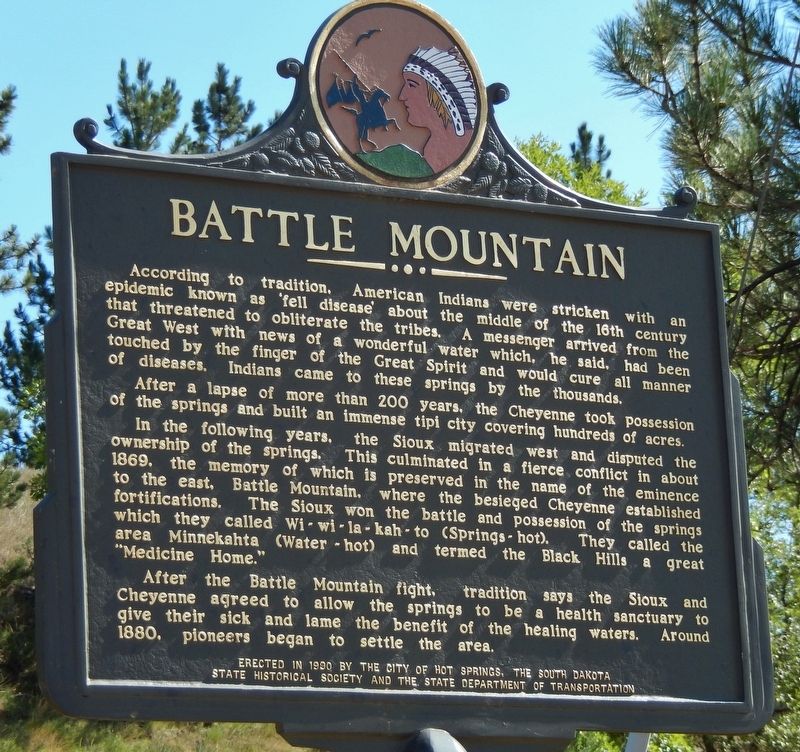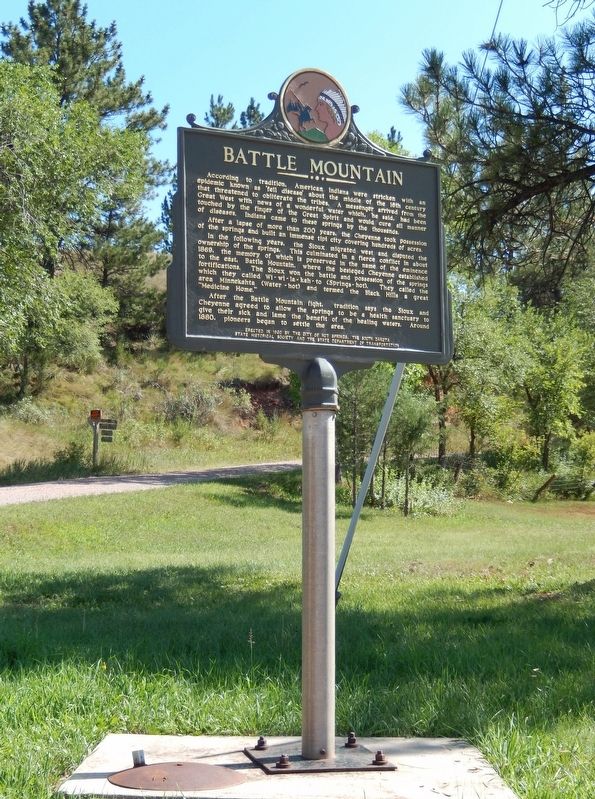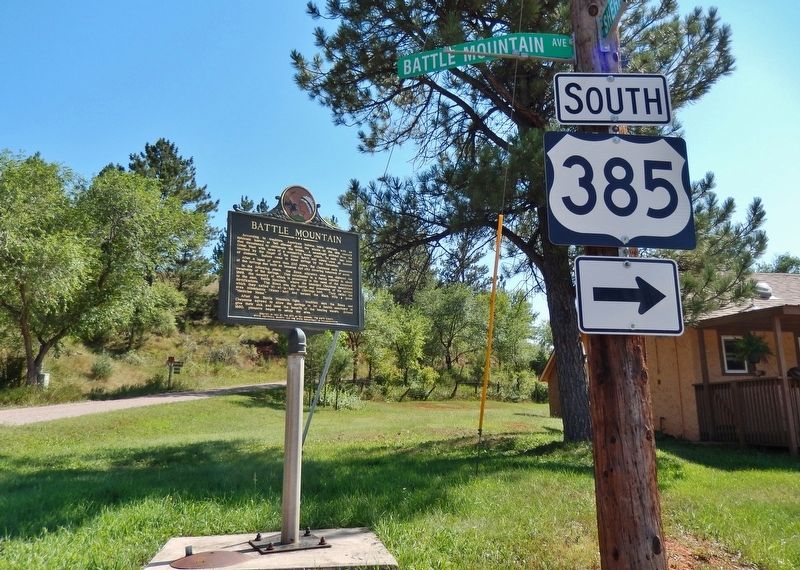Hot Springs in Fall River County, South Dakota — The American Midwest (Upper Plains)
Battle Mountain
After a lapse of more than 200 years, the Cheyenne took possession of the springs and built an immense tipi city covering hundreds of acres.
In the following years, the Sioux migrated west and disputed the ownership of the springs. This culminated in a fierce conflict in about 1869, the memory of which is preserved in the name of the eminence to the east, Battle Mountain, where the besieged Cheyenne established fortifications. The Sioux won the battle and possession of the springs which they called Wi-wi-la-kah-to (Springs - hot). They called the area Minnekahta (Water - hot) and termed the Black Hills a great “Medicine Home.”
After the Battle Mountain fight, tradition says the Sioux and Cheyenne agreed to allow the springs to be a health sanctuary to give their sick and lame the benefit of the healing waters. Around 1880, pioneers began to settle the area.
Erected 1990 by The City of Hot Springs, The South Dakota State Historical Society and the State Department of Transportation. (Marker Number 509.)
Topics and series. This historical marker is listed in these topic lists: Native Americans • Science & Medicine • Settlements & Settlers. In addition, it is included in the South Dakota State Historical Society Markers series list. A significant historical year for this entry is 1869.
Location. 43° 26.433′ N, 103° 28.499′ W. Marker is in Hot Springs, South Dakota, in Fall River County. Marker is at the intersection of Battle Mountain Avenue (U.S. 385) and Sherman Street, on the right when traveling north on Battle Mountain Avenue. Marker is located at the intersection where Sherman Street heads uphill from US Highway 385. Touch for map. Marker is in this post office area: Hot Springs SD 57747, United States of America. Touch for directions.
Other nearby markers. At least 8 other markers are within 5 miles of this marker, measured as the crow flies. An Old Jail - 1888 (approx. 0.4 miles away); Sandstone Architecture of Hot Springs, SD (approx. half a mile away); Mammoth Site of Hot Springs, SD (approx. 1.3 miles away); Hot Springs, SD (approx. 1.7 miles away); Leslie Jensen Scenic Drive (approx. 1.7 miles away); a different marker also named Leslie Jensen Scenic Drive (approx. 3.8 miles away); Fall River Falls
(approx. 4.3 miles away); John Stevenson Robertson: Pioneer Horticulturalist (approx. 4˝ miles away). Touch for a list and map of all markers in Hot Springs.
Also see . . .
1. Battle Mountain. In ancient times, Battle Mountain was used by Native Americans for flint to create arrowheads. According to legend, the thermal springs of the Fall River valley became popular to Native Americans, ultimately leading to a battle in 1869 between the Cheyenne and Sioux tribes for control of the springs, hence the name “Battle Mountain”. (Submitted on October 2, 2018, by Cosmos Mariner of Cape Canaveral, Florida.)
2. Hot Springs, South Dakota. The Sioux and Cheyenne people had long frequented the area, appreciating its warm springs. According to several accounts, including a ledger art piece by the Oglala Lakota artist Amos Bad Heart Bull, Native Americans considered the springs sacred. European settlers arrived in the second half of the 19th century. They first named the city "Minnekahta" after its Lakota name. It was renamed Hot Springs in 1882, which is a translation of the Native American name. A variety of health resorts were built on the tourism offered by the springs. (Submitted on October 2, 2018, by Cosmos Mariner of Cape Canaveral, Florida.)
Credits. This page was last revised on October 12, 2021. It was originally submitted on October 1, 2018, by Cosmos Mariner of Cape Canaveral, Florida. This page has been viewed 1,427 times since then and 177 times this year. Photos: 1, 2, 3. submitted on October 2, 2018, by Cosmos Mariner of Cape Canaveral, Florida. • Andrew Ruppenstein was the editor who published this page.


